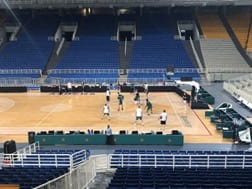By Bredan Buckley
Today we woke up in the region of Peloponnese, the southern isthmus of Greece. We spent the night in Tripoli which is in the center of the region and about half way between Olympia, which we visited the day before and the north-east area of the region which we are scheduled to visit today. Our hotel in Tripoli was by far the most luxurious we stayed in yet and had the best selection of breakfast options as well.
Everyone grabbed all their bags and headed across the plaza to our tour bus, piled on and for the most part fell back asleep on the bus. We had a bit of a drive ahead of us, as well as a long day, so this was probably a good strategy. After about two hours we arrived at our first stop, the ancient city of Mycenaean.
This city was the home of Agamemnon who was considered most famous for winning the Trojan war. This period and the stories of the Illiad and the Odyssey by Homer were generally considered fables or legend until the late 19thcentury when the ruins were found here and determined to be the actual home of Agamemnon and Helen of Troy. The fact that the site was found so recently contributed to one grave site having over thirteen kilograms of gold still buried with the family which is now on display in the archeological museum in Athens.
What is generally believed to be the tomb of Agamemnon was not so fortunate and when archeologists entered, it was completely empty. Well mostly empty. In the tomb portion of the site there were bats. We also found out our tour guide Sjoerd is afraid of bats.
We met up with a group of Dutch senior citizens who were on a seven week RV tour of Europe. Meeting other travelers on our trip has been enjoyable and informative.
The gift shop was disappointing. The Greeks have a lot to learn from the Catholics. And Disneyland.
We were back on the bus around noon and heading toward Epidaurus. The real gem of Epidaurus is the Ancient Theater of Epidaurus which was built in the third century B.C. and the upper level was added in the second century B. C.
This theater is not the biggest example from ancient Greece, but it is the most well preserved. Even today there is an annual summer festival here and no audio enhancement is necessary because of the superior acoustics of the theater.
Our local guide had us clap from the center of the theater and we could hear the acoustics of the theater in action. Then Patch sang Maroon 5 “She Will Be Loved” from the center of the theater to test the acoustics. He did a great job.
An hour later and we were back on the bus to Corinth. The lack of sleep is catching up to many in the group. Every time we are on the bus, many people are asleep within 15 minutes.
They are missing some beautiful countryside and shore line views.
We stopped in Corinth for lunch.
At 3:00 we entered the ancient ruins, starting at the temple of Apollo.
It was unique because the columns are monolithic (made from one piece of marble) which we have not seen up until this point in the trip. Corinth was the first city in Greece to mint its own coins. Corinth has 2 ports, Agean sea and Ionian Sea. St Paul introduced Christianity to Greece. Paul stayed in Corinth for 18 months and wrote two letters, First and Second Corinthians in the Bible.
Because Corinth is an isthmus, creating a canal has long been a goal of the Greek people. Construction started on the canal in 1884 and finished ten years later in 1894. The Canal separates Peloponnesus from main land Greece.
The canal is 6.5 KM long, 30 meters deep, and has 900 meter walls down to the water. It cost 80 Euro to bungee jump from the bridge.
The ride back there was much discussion of everyone’s favorite part of the trip so far. Everyone was on their own for dinner. Several folks went up to the roof top terrace of our hotel to enjoy the evening and the views. Everyone is looking forward to our free day in Athens tomorrow.













































































